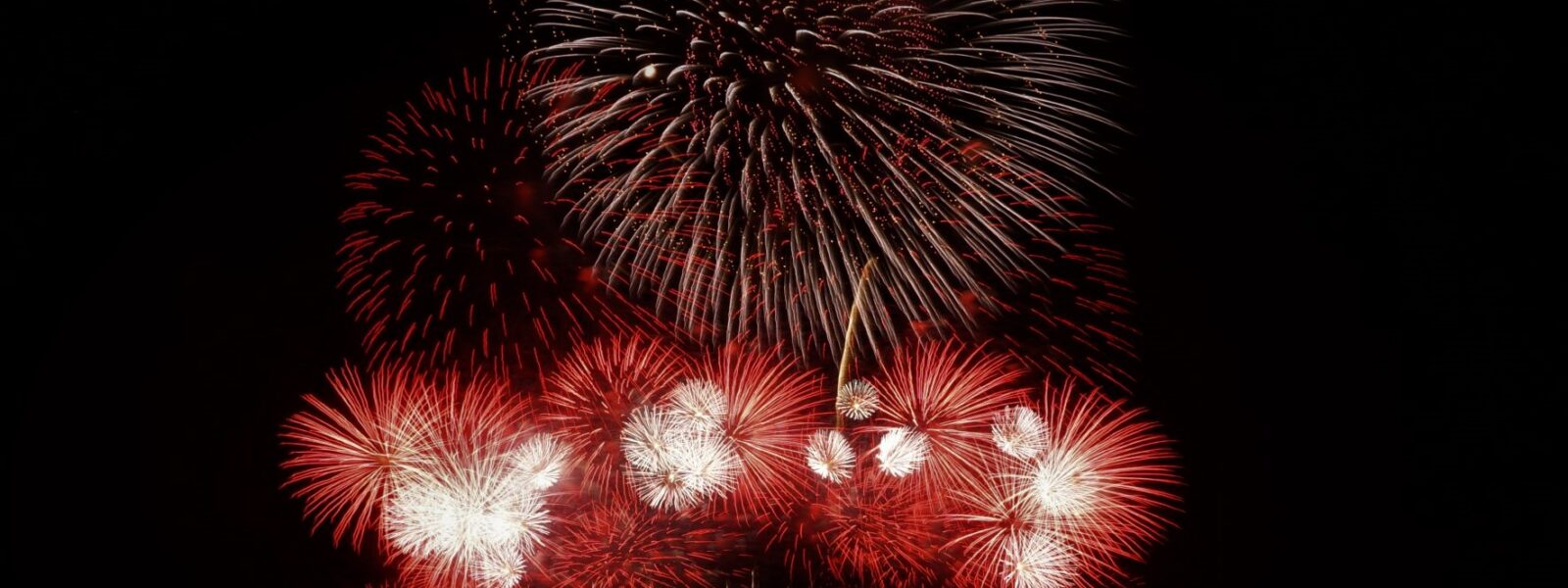Engineering Processes
2-1. The structure of fireworks
The cross-sectional image of a spherical aerial shell is illustrated below. Stars are small pellets of pyrotechnic composition that burn in the air creating a color flame or other effects. The break charge is the name of gunpowder used to burst the shells. The break charge is usually put in the center of the shells. When the shell is lighted, the fire reaches the center of the shell through the time fuse. When the break charge causes the burst, the stars fly in radial directions and start to burn. Afterward the hollow sphere of the stars appears in the air, and if the stars continue to burn they will drop with the force of the gravity.
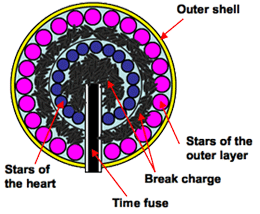
2-2. Mortars
Mortars are rigid tubes used for firing. Mortars for aerial shells and mines are made of various materials including paper and wood. While mortars made of heavy, thick steel were mainly used before, nowadays thin steel and Fiber Reinforced Plastics (FRP) are more popular. For starmine shows, 4 or 5 mortars are connected in sequence to ignite dozens or hundreds of shells in turn.
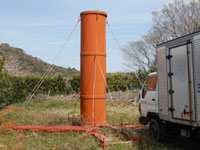 | 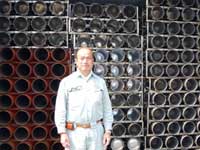 |
| A large mortar for the size of No. 30 fireworks balls | In front of the storehouse of mortars. They are for No. 5 fireworks balls. |
A mechanism for shooting a spherical aerial shell is illustrated below. A spherical aerial shell is set inside of the mortar with the adequate amount of lift charge, (lift charge is the gunpowder for shooting aerial shells). When the lift charge is ignited by a pilot light or an electrical starter, the fireworks ball is shot out from the mortar.

Immediately after the ignition of the lift charge, the time fuse lights the fireworks ball. The length and the diameter of the time fuse are decided so that the break charge ignites when the fireworks ball reaches its peak height.
Thus these two types of gunpowder: lift charge and break charge, enable the spherical aerial shell to shoot into the air and to burst. It is essential that the various factors including the size of the fuse and the amount of the lift charge should be controlled in minute detail to accomplish the ideal break-off in the air.
2-3. Production of spherical aerial fireworks
2-3-1. Production facilities
The production of fireworks contains risks of explosion in every step of the process. Therefore, extreme care should be taken to treat gunpowder. In the production facilities,
- Heat
- Impact
- Static electricity
should be avoided as completely as possible. Our factory is constructed in strict obedience to the Japanese Exclusives Control Law. Anyone entering the production area is required to put on anti-static clothing and shoes. Furthermore, in some areas staff are required to touch a neutralization apparatus before beginning operations.
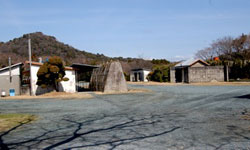 |  |
| Each workshop should maintain a regulated distance between the surrounding cottages. | Every storehouse of gunpowder should be encompassed with security barriers. |
The production processes of spherical aerial shells are shown in a following flowchart.
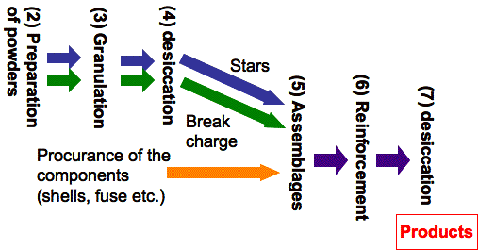
2-3-2. Preparation of gunpowder
In San-en Fireworks, we prepare our own stars and break charges by mixing the raw materials. The other necessary components are purchased for fabrication.
2-3-3. Granulation of stars
Stars burn in the air with variety of effects. The most typical effect is a colored flame such as blue, green or red. The flame color of the stars is a result of a chemical reaction caused by overheated color generating composite ions (usually metal, alkali or alkaline earth metal composites). For example, stars containing SrCO3 create a red color, and CuO for blue [K.L and B.J. Kosanke, 2004]. Other stars have long tails called comets. Others sparkle, or burn with an extremely bright flash. In many cases they are derived from metal ingredients, such as aluminium or titanium.
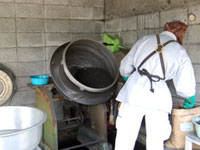
In San-en Fireworks, spherical stars are prepared by mixing gunpowder and functional additives. Then the mixture is granulated to make it easier to handle. In the beginning of the granulation process, core ingredients consisting of small pieces of gunpowder or seeds are slowly rotated in the granulation vessel. A small amount of gunpowder dispersion liquid is added to the vessel. During this process, the vessel is tilted to keep the movement of the granules inside and to avoid agglomeration. By stirring continuously and constantly adding small amounts of dispersion liquid, the size of the stars gradually increase.
2-3-4. Desiccation of stars
After the granulated stars are grown to the required size, they are dried in the sun for a couple of days.
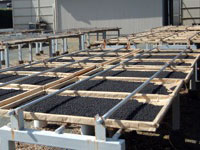
The break charge is prepared by similar processes. It is made by coating chaffs with a dispersion of gunpowder.
2-3-5. Assemblages of spherical shells
Stars, break charges, and other components are assembled in this process. Firstly hemispheres of spherical aerial shells are prepared. Then the components of the spherical aerial shell, stars, and break charges are lined from the outside to the center side of the outer shells. After all the ingredients are packed, the top surfaces of the hemispheres are flattened using a wooden board. Finally the two hemispheres are combined to make a spherical shell.
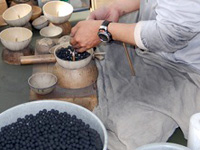 | 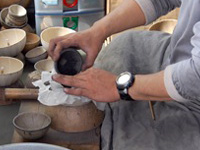 | 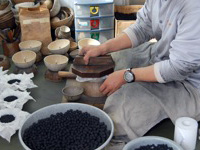 |
| 1. Stars for the outer layer are lined up just inside the paper shell. | 2. Pieces of thin paper are used to separate the stars from the break charge, and are placed between the star layers and at the center. | 3. The top surface of the hemisphere is flattened before another hemisphere is joined. |
2-3-6. Reinforcement
The fabricated shells are reinforced by covering them with layers of long strips of craft paper.
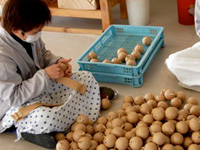 | 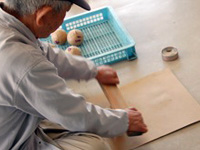 |
| Taping of shells | Wooden boards are used to bear down the shell to tighten the stick of craft paper. |
The number of layers and the strength of the papers affect the strength of the shells against bursts. Thus the strength of the reinforcement also affects the point of burst in the air. Therefore, this process is as important for pyrotechnicians as the other processes. To acquire the optimum result, it is necessary to adhere the craft paper as tightly as possible.
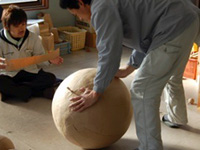
More experienced skills are required to reinforce shells larger than No. 10 because they are heavy and difficult to handle. This process requires two staff members. In the following photo, a No. 20 fireworks ball is rotated. Care is taken not to bend the time fuse on the top side.
2-3-7. Desiccation
The spherical aerial shells are dried in the sun. After desiccation, the craft paper shrinks and becomes tighter. The reinforcement and desiccation processes are repeated up to dozens of times in order to finish the products.
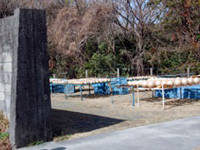 | 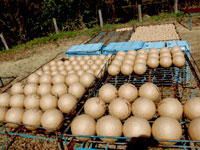 |
| The drying shelves are separated by security barriers from the other process. | The shells desiccated in the sun. |
The length of time for the whole production processes differs according to conditions such as the weather, seasons, and production scales. No. 5 stars usually require one month for preparation, and other processes take an additional month.
